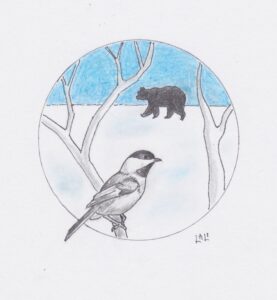It’s hard to get anything right these days. Take the feeding of backyard birds. What more innocent pastime can there be? And it’s more than simply entertaining. It is—or at least it was supposed to be—good for the environment, making the lives of birds, who are threatened by everything from domestic cats to wind turbines, a little easier.
But now it turns out that feeding the birds is bad for the bears. Attracted by seed and suet, hungry bears lumber into suburbs and knock over bird feeders, forage in garbage cans, and scare people. As a result they are relocated or, more often, killed.
To keep the bear problem under control, the Vermont Department of Fish and Wildlife recommends putting out bird feeders only from December through March. But four measly months out of twelve is hardly satisfying to me, who used to look forward to the seasonal variations in our bird guests, from the gray little winter residents—chickadees, titmice, nuthatches—to the colorful spring and summer arrivals, such as the rose-breasted grosbeak, who looks like it’s been stabbed in the chest, and the Halloween-hued Baltimore Oriole.
As if that weren’t bad enough, the Fish and Wildlife people warn that bird feeders should be left out only if “it’s generally wintry out for an extended period of time, with consistent snow on the ground and temperatures at or below freezing.” Otherwise the bears, who are not true hibernators, will come out of their cold weather torpor and resume their raids on human habitats.
I’m sorry to report that, even in Vermont, global warming has made sustained snow cover and persistent below-freezing temperatures the exception rather than the rule. It did snow a bit here last night, but by the weekend temperatures will be in the 40s and 50s. I guess that means that I’ll have to bring the birdfeeders inside, or risk a bear visit.
If you look at wildlife- and bird-oriented websites, you will find that feeding the birds is mostly treated as something that a well-intentioned portion of the population is addicted to, and may be indulged within certain parameters. In fact, wildlife specialists insist, birds don’t really need to be fed, especially during the warmer months. Some make it sound as if, what with the dangers of attracting bears and rodents, and posing disease risks to the birds, birdfeeders do more harm than good.
It looks to me like the solution to the birds and the bears problem is simply to leave the birds alone to find their own food, and ditto the bears. And when you think about it, isn’t that pretty much the key to the ecological crisis of our age: leave Nature alone? She knows what she’s doing, and She will take care of her own.
If only that were possible! But everything we do, every breath we take interferes with someone or something out there. Driving to the store to buy a plastic-wrapped protein bar that includes chocolate from Ghana and coconut from New Guinea interferes. Wrapping holiday gifts in paper printed with candles and holly wreaths interferes. And when I fill my humidifier with two quarts of water daily to keep my indoor plants happy, I’m interfering.
What to do? How to be in these unprecedented times? There are no guaranteed solutions, only general indications of how to proceed, in which the operative word seems to be less—use less, waste less, eat less (or at least eat lower on the food scale). Feed the birds less. And if we all do the best we can, maybe with luck the birds will thrive on their natural diets, the bears will prosper in the woods, and we will be at peace with them and with our conscience.



One Response
Wise advice